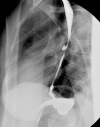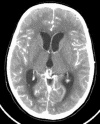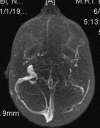Lower cranial nerve palsy, aseptic meningitis and hydrocephalus: unusual presentation of primary antiphospholipid syndrome
- PMID: 21874138
- PMCID: PMC3029531
- DOI: 10.1136/bcr.06.2009.2013
Lower cranial nerve palsy, aseptic meningitis and hydrocephalus: unusual presentation of primary antiphospholipid syndrome
Abstract
Presentation of primary antiphospholipid syndrome (APS) is usually untrustworthy and unusual presentations are difficult to diagnose on the basis of clinical features alone. This is true especially in young and elderly patients. Cerebral venous thrombosis (CVT) is less frequent than arterial thrombosis in APS. CVT has a wide spectrum of signs and symptoms, which may evolve suddenly or over weeks. It mimics many neurological conditions such as meningitis, encephalopathy, benign intracranial hypertension and stroke. Headache is the most frequent symptom in patients with CVT, and is present in about 80% of cases. The most common pattern of presentation is with a benign intracranial hypertension-like syndrome. Sixth cranial nerve palsy usually manifests as a false localising sign. Patients may have recurrent seizures. Cranial nerve syndromes are seen with venous sinus thrombosis. We present a case of APS with lower cranial nerve palsy, aseptic meningitis and hydrocephalus initially treated as tuberculous meningitis.
Figures




Similar articles
-
Cerebral venous thrombosis--clinical presentations.J Pak Med Assoc. 2006 Nov;56(11):513-6. J Pak Med Assoc. 2006. PMID: 17183979 Review.
-
Cerebral venous thrombosis presenting as multiple lower cranial nerve palsies.Indian J Crit Care Med. 2012 Oct;16(4):213-5. doi: 10.4103/0972-5229.106505. Indian J Crit Care Med. 2012. PMID: 23559730 Free PMC article.
-
Progressive Cerebral Venous Thrombosis with Cranial Nerve Palsies in an Adolescent African Girl & Associated Diagnostic Pitfalls: A Rare Case Report.Int Med Case Rep J. 2023 Jan 12;16:45-51. doi: 10.2147/IMCRJ.S381748. eCollection 2023. Int Med Case Rep J. 2023. PMID: 36660226 Free PMC article.
-
Polyradiculopathy and Multiple Cranial Nerve Palsies - Rare Manifestations of Cerebral Venous Sinus Thrombosis.Neurol India. 2021 Jan-Feb;69(1):170-173. doi: 10.4103/0028-3886.310084. Neurol India. 2021. PMID: 33642294
-
Headache and cerebral vein and sinus thrombosis.Front Neurol Neurosci. 2008;23:89-95. doi: 10.1159/000111263. Front Neurol Neurosci. 2008. PMID: 18004055 Review.
Cited by
-
Systemic autoimmune diseases complicated with hydrocephalus: pathogenesis and management.Neurosurg Rev. 2019 Jun;42(2):255-261. doi: 10.1007/s10143-017-0917-x. Epub 2017 Nov 12. Neurosurg Rev. 2019. PMID: 29130124 Review.
-
Profound changes in cerebrospinal fluid proteome and metabolic profile are associated with congenital hydrocephalus.J Cereb Blood Flow Metab. 2021 Dec;41(12):3400-3414. doi: 10.1177/0271678X211039612. Epub 2021 Aug 20. J Cereb Blood Flow Metab. 2021. PMID: 34415213 Free PMC article.
References
-
- Sastre-Garriga J, Montalban X. APS and the brain. Lupus 2003; 12: 877–82 - PubMed
-
- Honczarenko K, Budzianowska A, Ostanek L. Neurological syndromes in systemic lupus erythematosus and their association with antiphospholipid syndrome. Neurol Neurochir Pol 2008; 42: 513–17 - PubMed
-
- Sugimoto T, Takeda N, Yamakawa I, et al. Intractable hiccup associated with aseptic meningitis in a patient with systemic lupus erythematosus. Lupus 2008; 17: 152–3 - PubMed
-
- Dedo DD. Pediatric vocal cord paralysis. Laryngoscope 1979; 89: 1378–84 - PubMed
LinkOut - more resources
Full Text Sources
Miscellaneous
